One of the things that you will often encounter when driving are road warning signs. There are plenty of road warning signs here in the UK and being able to recognize them will greatly help you become a safer and a better driver. Below are the common warning signs included in the Highway Code test that you’ll encounter when you drive in the UK.
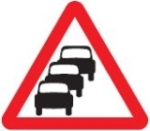 |
Traffic queues likely ahead. The queues might be hidden (in which case there could be an additional warning sign). Be prepared to have to stop and also be aware of vehicles following you that might be following too closely; if you brake heavily they could run into the back of you, so it’s best to start slowing down early, brake smoothly and be aware of what’s around you. |
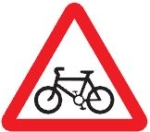 |
Cycle route ahead. Be on the lookout for bikes. |
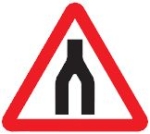 |
Dual carriageway ends ahead. Traffic will merge from two lanes to one lane. Merge like a zip and try to maintain your speed as not to disrupt the traffic flow (unless there’s a new speed limit ahead). |
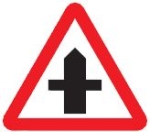 |
Crossroads ahead. Keep a look out for vehicles that might be turning into the road in case they don’t see you. |
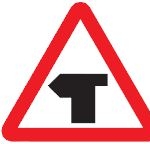 |
Junction on bend ahead. The road bears to the left but there is a right turn junction on the bend. Be careful as vehicles may be stopping on the bend to turn. |
 |
Bend to the right ahead. This bend might be sharper than it appears, or could be hidden or off-camber. Take care and adjust your speed appropriately. |
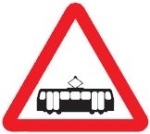 |
Trams crossing ahead. You may have to stop and give way. |
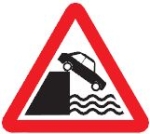 |
Quayside or river bank ahead. There are several potential dangers here. If it’s a river bank and it’s a grassy slope, bear in mind that it’s at all wet (dewy or damp or sodden) it can be very slippery and it could mean that you can’t get your car back up the bank, or it might slip down the slope. If it’s a quayside, sometimes the edge is difficult to see, especially when reversing. Be careful you don’t reverse over the edge. If you parallel park against the quayside, if you try to reverse out of the park then your front wheels will swing towards the edge and you risk dropping a wheel over. That makes for an expensive recovery situation, you will almost certainly damage the underside of your car, and you risk the car tipping into the water. |
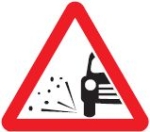 |
Loose chippings ahead. Flying stones can crack your windscreen or other drivers’ screens. Keep your speed down to minimise the chance of this happening. Also be aware that the road might not have as much grip because of the loose stones. To take Highway Code questions about handling, click here. |
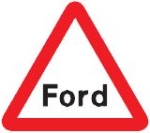 |
Shallow stream/river crossing ahead. Slow down so that you don’t blind other drivers with your spray and you also reduce the risk of spraying water up into your engine that might cause you to stall. Remember to dry your brakes afterwards. |
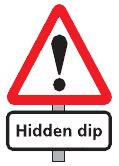 |
Other danger ahead; plate indicates nature of danger. In this case it’s a hidden dip. This dip could be severe enough to bottom out your suspension and that could cause your car damage and, worse, cause you to leave the road. |
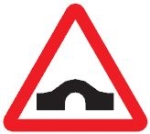 |
Hump bridge ahead. Slow down because the bridge will probably be steep enough that you risk your wheels leaving the road if you are going too fast. Also, look out for vehicles coming from the other direction as you might not be able to see them straight away. Some hump bridges are narrow and you might see a sign that indicates you either have or don’t have the right of way over traffic coming the other direction. |
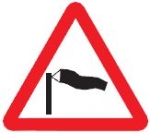 |
Crosswinds ahead. These are particularly dangerous to high-sided vehicles such as lorries, and motorbikes. The gusts can blow you into the other lane which increases your risk of having a head-on crash. Cars can be affected, too. Figure out which way the wind is blowing, then drive to the conditions by positioning your vehicle on the road such that a strong gust has less likelihood of blowing you out of the lane. Slow down, too, as the faster you are going, the more distance you will travel towards the edge of your lane before you have time to correct it. There are Highway Code questions here regarding driving in challenging conditions on your motorbike. |
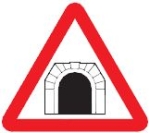 |
Tunnel ahead. Be especially aware that your eyes might take a few seconds to adjust to the different light levels. If your car does not have automatic lights, you should turn your lights on. |
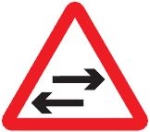 |
Two-way traffic crosses one-way road ahead. Be sure to look left and right and take care. |
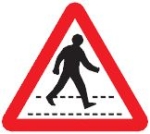 |
Zebra crossing ahead. Be prepared to stop if there are pedestrians waiting to cross. Keep an eye out for small children, too, as they are more unpredictable. |
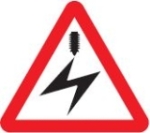 |
Overhead electric cable ahead. If you are driving a tall vehicle, or a vehicle with tall aerial or load, this sign might be accompanied by a height warning. Know the height of your vehicle so that you don’t interfere with the power lines. |
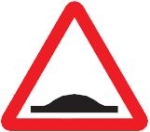 |
Road humps ahead. These bumps can cause you to lose control if you are travelling too fast as they reduce the grip your tyres have as you crest the bump. Coming down on the otherside of the bump can cause suspension damage if you travel too fast. |
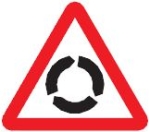 |
Roundabout ahead. Be prepared to stop and give way to your right. Make sure you get in the correct lane early and indicate your intentions on the roundabout. |
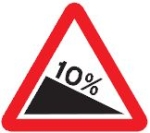 |
Steep hill downwards ahead. The sign shows the direction and the gradient (in this case 10% or 1 metre every 10 metres, which is steeper than it sounds). Heavy vehicles will want to consider changing down a gear to preserve brakes. All vehicles should increase following distances as it takes longer to stop when going downhill. |
